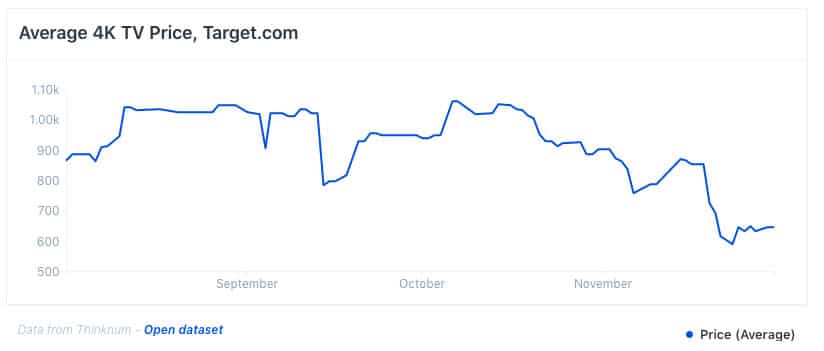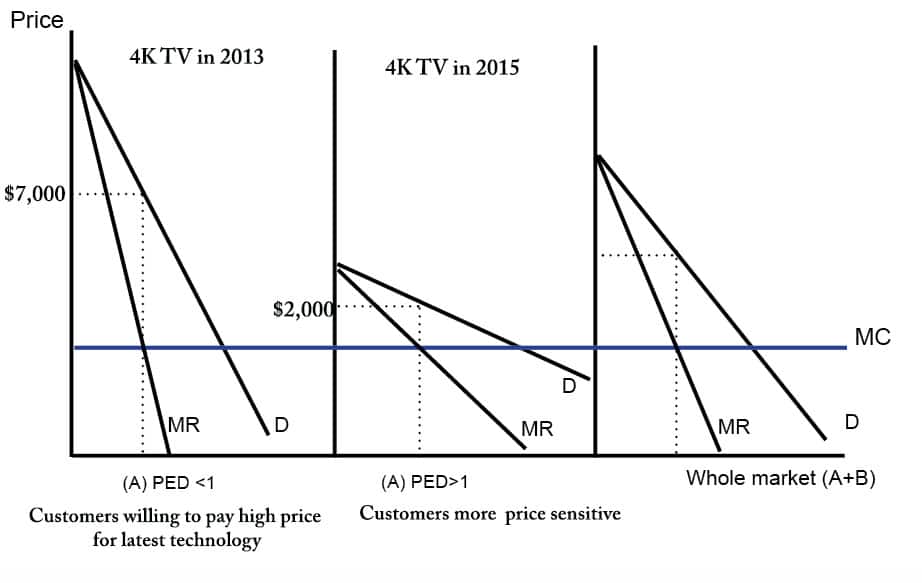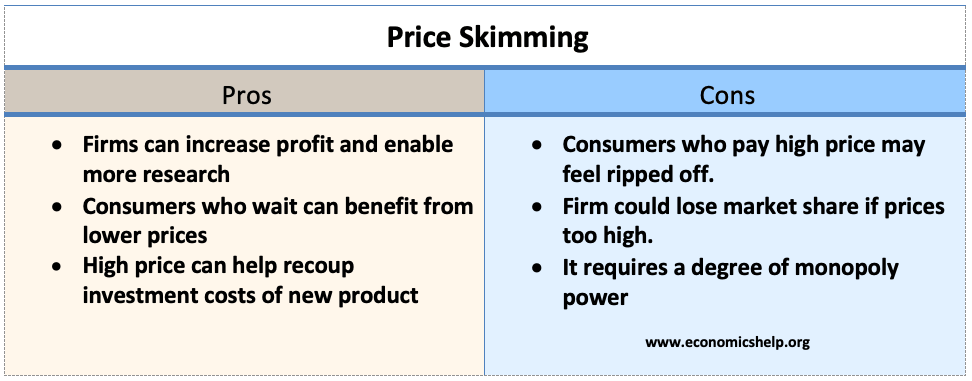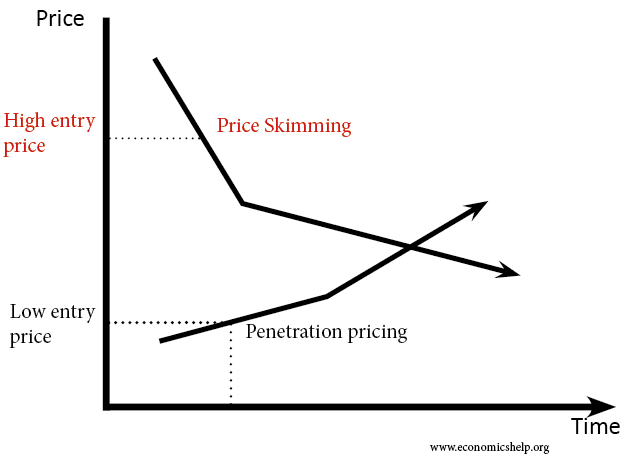Price skimming is a business strategy to set a high price on entry to the market and then reduce the price over time.
The logic of price skimming is to take advantage of customers who have inelastic demand and are willing to pay the high price. When these consumers have bought the good, the firm can then reduce the price to attract a wider group of consumers who are more price sensitive (elastic demand)
Price skimming can enable a firm to increase its overall profits – though there is a risk that the customers who pay the initial high price may later feel cheated. Those consumers who are prepared to wait will benefit from lower price.
Examples of price skimming
- Apple iPhone
- Sony PlayStation 3
- Latest 3d Printer
- Lastest 4K/8K televisions
Price skimming works well for innovative and high tech goods that certain groups of consumers eagerly anticipate. Price skimming also requires a degree of monopoly power – primarily strong brand loyalty. When the latest mobile phone comes out, some consumers want to buy as soon as possible. (e.g. queues of customers outside Apple Stores). It is part status symbol, part desire to have the best mobile phone. Therefore, this group who are keen to buy, typically have very inelastic demand. Price is only one small factor, and so they are willing to pay the very high prices.
Example of 4K TVs
In 2012 the first 4K Ultra High-Definition TVs went on sale in the U.S. The price of the 4K TV was $20,000. A year later the price was around $7,000 (USA today) Today prices are falling below $1,000.
4k TV prices in 2019

Part of the fall in price could be due to improved technology and lower costs of production. Early sales also did not have the same economies of scale.
However, there is definitely an element of price skimming. Only very few customers are willing to pay $7,000 + for a tv. But, early adopters of new technology can be the first to gain a new type of tv – if they are willing to pay a higher price.
The longer customers are prepared to wait, the lower prices are likely to fall.
Note: with this comparison of 4k TVs, companies are bringing out different models. True price skimming occurs when the firm reduces the price of the same model. However, there is an element of both. The initial price of 4k/8K tvs are often reduced over time.
8K TVs
8K TVs are now available. Their prices are reminiscent of the price of 4K tv’s a few years ago. For example, the Samsung QE82Q950, 82″ is on sale at Curry’s for £9,999. If you are prepared to wait a few years, the average price of 8K tv’s is bound to fall. At the moment the 8K TV market is aimed at the high-income and those with inelastic demand. In five years, the 8K TV market will be aimed at a much wider audience and prices will reflect this.
A form of price discrimination?
The logic of price skimming is similar to price discrimination. It is separating the different groups of consumers in the market by selling at different prices from one year to the next.

In 2013, the firm is targetting consumers who have very price inelastic demand. Those customers for whom price is no barrier, but their priority is getting the latest and best technology. Once these consumers have bought the tv, the firm needs to cut the price to attract a larger range of customers who are more price sensitive.
Price skimming enables more profits than if the introductory price had been low.
Pros and cons of price skimming

Advantages
- Firm can increase total profit, leading to more resources for research and development
- Customers who are prepared to wait can benefit from falling prices.
- When a firm enters a new product into the market, it will not yet have the economies of scale so may need to charge higher prices to reflect higher average costs. As sales grow and it gains economies of scale, it can afford to cut prices.
Disadvantages
- Customers who bought early, may feel they have been ‘ripped off’ when the same product is sold for a lower price. This may create a negative image of the firm. Some early adopters of the Sony Playstation 3 feel that they have been taken advantage of.
- Selling at a high price means that the firm will only be selling small quantity for the early period. This could make it vulnerable to losing market share to a cheaper rival. For example, Android phones have increasingly been taking market share from Apple.
- It requires a degree of monopoly power.
Evaluation
- A firm needs monopoly power and strong brand loyalty
- It works well where there is strong anticipation of the product
- The firm has to be careful not to annoy its own customers. Customers can feel badly treated if the price is cut after they buy it.
- It depends on the product. In a compeitive market, a firm trying to price skim would lose sales to rival firms.
- There may be other factors behind changing prices – such as lower costs of production (from economies of scale)
Comparison between price skimming and penetration pricing

Penetration pricing is the opposite approach. When a firm enters a competitive market by setting very low price to gain market share. Then when it has market share it slowly increases the price.
Related
